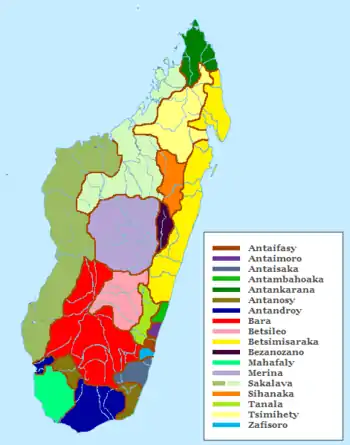Portal:Madagascar
The Madagascar Portal
Madagascar (/ˌmædəˈɡæskər, -kɑːr/; Malagasy: Madagasikara, pronounced [ma.da.ɡa.si.kʲa.ra]), officially the Republic of Madagascar (Malagasy: Repoblikan'i Madagasikara, Malagasy pronunciation: [repuˈblikʲanʲ madaɡasʲˈkʲarə̥]; French: République de Madagascar) is a sovereign island country in the Indian Ocean, approximately 400 kilometres (250 miles) off the coast of East Africa across the Mozambique Channel. At 592,800 square kilometres (228,900 sq mi), it is the world's second-largest island country, after Indonesia. Its capital and largest city is Antananarivo. Home to around 30 million people, Madagascar consists of an eponymous main island (the world's fourth largest by area) and numerous smaller peripheral islands. Following the prehistoric breakup of the supercontinent Gondwana, Madagascar split from the Indian subcontinent around 90 million years ago, allowing native plants and animals to evolve in relative isolation; consequently, it is a biodiversity hotspot and one of the world's 17 megadiverse countries, with over 90% of wildlife being endemic. Madagascar was first settled during or before the mid first millennium AD by Austronesian peoples, presumably arriving on outrigger canoes from present-day Indonesia. These were joined around the ninth century AD by Bantu migrants crossing the Mozambique Channel from East Africa. Other groups continued to settle on Madagascar over time, each one making lasting contributions to Malagasy cultural life. Subsequently, the Malagasy ethnic group is often divided into 18 or more subgroups, of which the largest are the Merina of the central highlands. (Full article...)
| |||||||
 Mounted Skeleton, Stony Brook University |
Majungasaurus (/məˌdʒʌŋɡəˈsɔːrəs/; lit. 'Mahajanga lizard') is a genus of abelisaurid theropod dinosaur that lived in Madagascar from 70 to 66 million years ago, at the end of the Cretaceous Period, making it one of the last known non-avian dinosaurs that went extinct during the Cretaceous–Paleogene extinction event. The genus contains a single species, Majungasaurus crenatissimus. This dinosaur is also called Majungatholus, a name which is considered a junior synonym of Majungasaurus.
Like other abelisaurids, Majungasaurus was a bipedal predator with a short snout. Although the forelimbs are not completely known, they were very short, while the hind limbs were longer and very stocky. It can be distinguished from other abelisaurids by its wider skull, the very rough texture and thickened bone on the top of its snout, and the single rounded horn on the roof of its skull, which was originally mistaken for the dome of a pachycephalosaur. It also had more teeth in both upper and lower jaws than most abelisaurids. (Full article...)Selected article -
 Mahajanga Cathedral |
Mahajanga [maːˈdzaŋɡə̥] (French: Majunga) is a city and an administrative district on the northwest coast of Madagascar. The city of Mahajanga (Mahajanga I) is the capital of the Boeny Region. The district (identical to the city) had a population of 220,629 in 2013.
Mahajanga is a tourist destination for Malagasy tourists and international travelers, with beaches, a coconut-lined boardwalk ("Le Bord", short for "Bord de la mer" or sea-side), and eight months of hot, virtually rain-free weather. (Full article...) Good article -
Good article -
Andrianjaka reigned over the Kingdom of Imerina in the central highlands region of Madagascar from around 1612 to 1630. Despite being the younger of King Ralambo's two sons, Andrianjaka succeeded to the throne on the basis of his strength of character and skill as a military tactician. The most celebrated accomplishment of his reign was the capture of the hill of Analamanga from a Vazimba king. There he established the fortified compound (rova) that would form the heart of his new capital city of Antananarivo. Upon his orders, the first structures within this fortified compound (known as the Rova of Antananarivo) were constructed: several traditional royal houses were built, and plans for a series of royal tombs were designed. These buildings took on an enduring political and spiritual significance, ensuring their preservation until being destroyed by fire in 1995. Andrianjaka obtained a sizable cache of firearms and gunpowder, materials that helped to establish and preserve his dominance and expand his rule over greater Imerina.
Many of the cultural practices that were to define Merina social and political life for centuries are credited to Andrianjaka. He designated the twelve sacred hills of Imerina that were to become the spiritual and political heartland of the Merina empire, contributing to the establishment of the kingdom's traditional boundaries; clans were assigned to specific regions within his kingdom, further defining the cultural landscape. He consolidated power through such measures as appropriating the folk tradition of sampy (community talismans), thereby ensuring all the powers traditionally attributed to these idols were under the control of the sovereign alone. Merina traditions related to the burial and mourning of sovereigns are also traced back to Andrianjaka's reign. (Full article...)General images -
Selected panorama
Topics
Categories
Selected picture
Associated Wikimedia
The following Wikimedia Foundation sister projects provide more on this subject:
-
 Commons
Commons
Free media repository -
 Wikibooks
Wikibooks
Free textbooks and manuals -
 Wikidata
Wikidata
Free knowledge base -
 Wikinews
Wikinews
Free-content news -
 Wikiquote
Wikiquote
Collection of quotations -
 Wikisource
Wikisource
Free-content library -
 Wikispecies
Wikispecies
Directory of species -
 Wikiversity
Wikiversity
Free learning tools -
 Wikivoyage
Wikivoyage
Free travel guide -
 Wiktionary
Wiktionary
Dictionary and thesaurus
-
 List of all portalsList of all portals
List of all portalsList of all portals -
 The arts portal
The arts portal -
 Biography portal
Biography portal -
 Current events portal
Current events portal -
 Geography portal
Geography portal -
 History portal
History portal -
 Mathematics portal
Mathematics portal -
 Science portal
Science portal -
 Society portal
Society portal -
 Technology portal
Technology portal -
 Random portalRandom portal
Random portalRandom portal -
 WikiProject PortalsWikiProject Portals
WikiProject PortalsWikiProject Portals








_Madagascar.jpg.webp)




.jpg.webp)




.svg.png.webp)







.jpg.webp)














.jpg.webp)





.jpg.webp)



